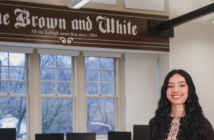
Rebecca Wilkin
A wave of silence swept over The Brown and White newsroom as we watched the election results flood in early Wednesday morning. Most of us were in shock.
The day before the national election, The New York Times had Donald Trump at a 15 percent chance of winning the presidency, while Nate Silver’s FiveThirtyEight gave Trump a 28.6 percent chance of securing a victory.
Even the Trump campaign itself estimated the candidate’s chances of winning the presidency at one in five. The Huffington Post had the probability of Trump winning at slightly over 1 percent. Most polls pegged Hillary Clinton easily capturing key battleground states.
So how did this happen? How did the major media outlets get this so wrong?
The election results puzzled pollsters and pundits alike. Although Hillary Clinton won the popular vote, Trump secured a landslide victory in electoral votes and won 290 votes to Clinton’s 228.
According to business reporter Nathan Bomey of USA Today, pollsters misjudged Trump’s support among white voters and overestimated Clinton’s support from minority groups.
Two thirds, or 67 percent, of non-college educated whites voted for Trump, while 28 percent voted for Clinton. This 39-point margin was the largest for any candidate in the exit polls since 1980.
According to CNN, African-American, Latino and young voters did not show up to vote in sufficient numbers to secure a victory for Clinton. While she did win in these demographic groups, she underperformed President Barack Obama.
In fact, fewer Democrats voted this year than in the past two elections. In 2008, almost 70 million Democrats voted for Obama compared to the 60 million Republicans who voted for candidate Mitt Romney. On Tuesday, fewer than 60 million Democrats voted, and roughly the same number of Republicans cast their votes.
The polls also missed Clinton’s margin in the Midwestern and Rust Belt states, such as Wisconsin, Michigan and Pennsylvania. Clinton’s team was convinced it would win states like Wisconsin and Michigan, and they even stopped running most advertisements in these areas.
One reason the polls may have missed this margin was the unprecedented percentage of undecided voters. In final national polls, about 12 percent of voters were not committed to either candidate, compared to just three percent in the 2012 election.
According to exit polls, in most swing states, such as Pennsylvania and Wisconsin, late-deciding voters broke toward Trump.
Some analysts believe that a majority of Trump supporters simply remained silent. Perhaps some Trump supporters were reluctant or embarrassed to tell the pollsters whom they favored.
Although most mainstream media outlets and pollsters did not see Trump’s victory coming, the University of Southern California Dornsife/Los Angeles Times presidential election poll did, in fact, predict Trump walking into the White House. On Tuesday morning, their poll showed Trump leading by slightly more than 3 percentage points.
The USC polling team was led by Arie Kapteyn, who said other polls may have misjudged the number of individuals who did not vote in the 2012 election and did, in fact, vote in this one.
Many of these individuals who did not vote in 2012 were more inclined toward Trump in this election than they were toward Clinton.
Kapteyn explained that his team used a different method of polling than other tracking polls. The team recruited about 3,000 respondents and polled these same respondents several times in the months prior to the election.
The poll was designed so that participants could rank their probability of voting and the candidate’s likelihood of winning on scale from 0 to 100. Kapteyn said this allowed for their poll to be more precise in detecting a shift in the sentiment of the voters.
Partisans on both sides criticized the USC Dornsife/Los Angeles Times tracking poll. Even FiveThiryEight was highly criticized for predicting that Clinton only had a 71 percent chance of winning the election.
FiveThirtyEight’s Nate Silver explained that polls tend to duplicate one another’s mistakes — a phenomenon known as “herding.” Many pollsters will skew their results to reflect a current mood, and this can ultimately lead to inaccuracies.
I cannot deny that the majority of mainstream media is biased to one side or another. But we must not be so quick to blame the media for this one. Even some of the most conservative outlets and Trump’s campaign itself did not anticipate Trump’s victory.
Numerous factors contributed to the inaccuracy of these polls — an abnormally high percentage of non-college educated whites arriving to the polling stations, the significant drop in the number of Democrats who voted Tuesday compared to previous elections, the high percentage of undecided voters, the number of individuals who were reluctant to admit to pollsters they supported Trump, and the number of 2012 non-voters who decided to cast votes in this election, among others.
But this does not mean we shouldn’t hold the media accountable. Nate Silver emphasized there was a large amount of uncertainty surrounding the election forecast, and most pollsters and media outlets seemed to ignore this crucial aspect.
Room for improvement certainly exists. Perhaps new polling strategies, like the one used by Kapteyn and his team at USC, can be adopted for future elections.
Or perhaps many of the major media outlets can be more transparent about their uncertainties and less skeptical of those pollsters and pundits who do not go along with the crowd for the sake of looking “correct.”
These media outlets themselves were shocked. But so were most U.S. citizens.
We cannot simply blame the mass media for these inaccurate polls. We can, however, hold it responsible for remaining transparent with us.
So, for now, we must move on.
—
Rebecca Wilkin, ’18, is the deputy news editor for The Brown and White. She can be reached at [email protected].





Comment policy
Comments posted to The Brown and White website are reviewed by a moderator before being approved. Incendiary speech or harassing language, including comments targeted at individuals, may be deemed unacceptable and not published. Spam and other soliciting will also be declined.
The Brown and White also reserves the right to not publish entirely anonymous comments.